The Cambridge History of China. Vol. 12: Republican China, 1912-1949, Part 1
Подождите немного. Документ загружается.

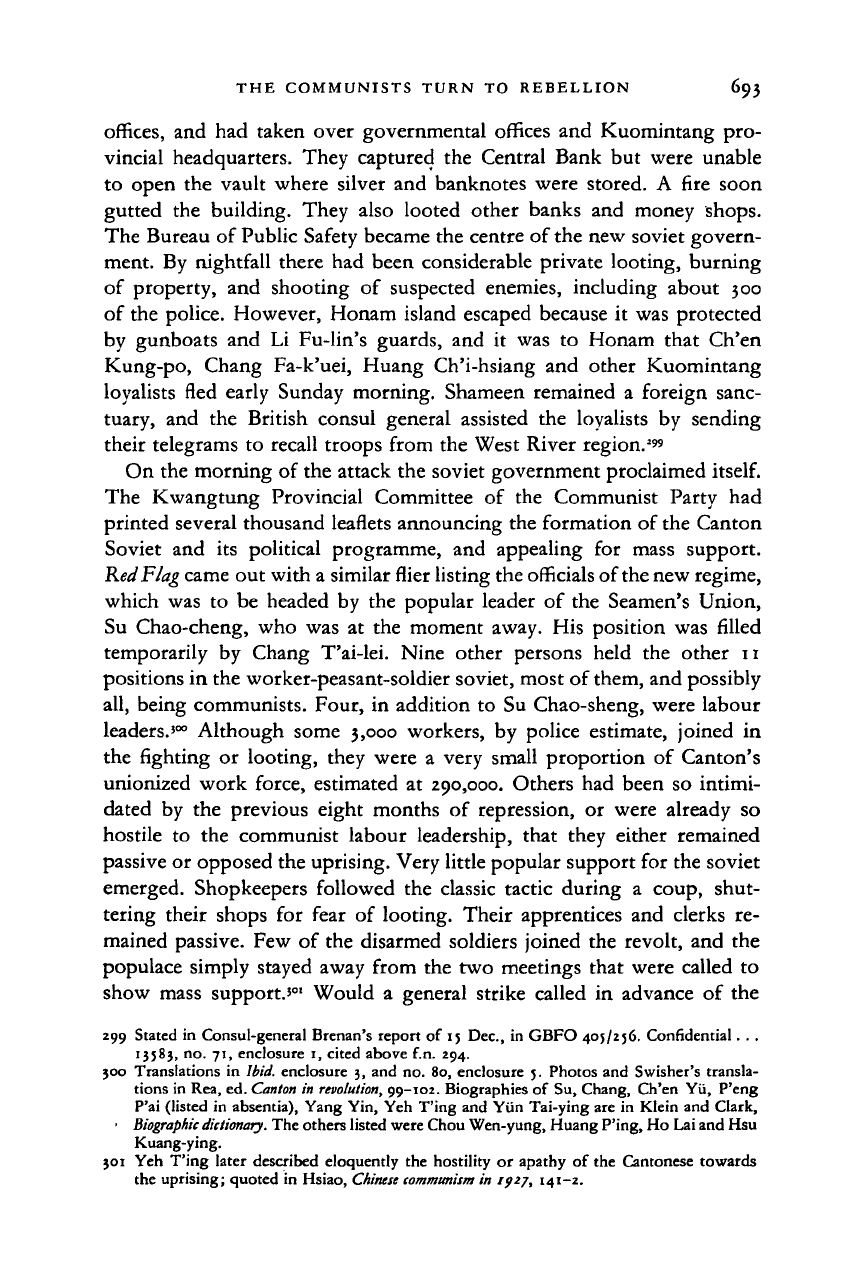
THE COMMUNISTS TURN TO REBELLION 693
offices, and had taken over governmental offices and Kuomintang pro-
vincial headquarters. They captured the Central Bank but were unable
to open the vault where silver and banknotes were stored. A fire soon
gutted the building. They also looted other banks and money shops.
The Bureau of Public Safety became the centre of the new soviet govern-
ment. By nightfall there had been considerable private looting, burning
of property, and shooting of suspected enemies, including about 300
of the police. However, Honam island escaped because it was protected
by gunboats and Li Fu-lin's guards, and it was to Honam that Ch'en
Kung-po, Chang Fa-k'uei, Huang Ch'i-hsiang and other Kuomintang
loyalists fled early Sunday morning. Shameen remained a foreign sanc-
tuary, and the British consul general assisted the loyalists by sending
their telegrams to recall troops from the West River region.
2
"
On the morning of the attack the soviet government proclaimed
itself.
The Kwangtung Provincial Committee of the Communist Party had
printed several thousand leaflets announcing the formation of the Canton
Soviet and its political programme, and appealing for mass support.
Red
Flag
came out with a similar flier listing the officials of the new regime,
which was to be headed by the popular leader of the Seamen's Union,
Su Chao-cheng, who was at the moment away. His position was filled
temporarily by Chang T'ai-lei. Nine other persons held the other 11
positions in the worker-peasant-soldier soviet, most of them, and possibly
all,
being communists. Four, in addition to Su Chao-sheng, were labour
leaders.'
00
Although some 3,000 workers, by police estimate, joined in
the fighting or looting, they were a very small proportion of Canton's
unionized work force, estimated at 290,000. Others had been so intimi-
dated by the previous eight months of repression, or were already so
hostile to the communist labour leadership, that they either remained
passive or opposed the uprising. Very little popular support for the soviet
emerged. Shopkeepers followed the classic tactic during a coup, shut-
tering their shops for fear of looting. Their apprentices and clerks re-
mained passive. Few of the disarmed soldiers joined the revolt, and the
populace simply stayed away from the two meetings that were called to
show mass support.>"• Would a general strike called in advance of the
299 Stated in Consul-general Brenan's report of 15 Dec, in GBFO 405/256. Confidential . . .
•3583,
no. 71, enclosure 1, cited above f.n. 294.
500 Translations in
Ibid,
enclosure 3, and no. 80, enclosure 5. Photos and Swisher's transla-
tions in Rea, ed.
Canton
in
revolution,
99-102. Biographies of Su, Chang, Ch'en Yii, P'eng
P'ai (listed in absentia), Yang Yin, Yeh T'ing and Yiin Tai-ying are in Klein and Clark,
•
Biographic
dictionary.
The others listed were Chou Wen-yung, Huang P'ing, Ho Lai and Hsu
Kuang-ying.
JOI
Yeh T'ing later described eloquently the hostility or apathy of the Cantonese towards
the uprising; quoted in Hsiao,
Chinese communism
in 1927, 141-2.
Cambridge Histories Online © Cambridge University Press, 2008

694 THE NATIONALIST REVOLUTION, I 9 2 3-8
uprising have made any difference? The Revolutionary Military Com-
mittee had decided against trying to call out a strike because the com-
munist position with labour was too weak; but later the Politburo
reproved them for this mistake.
On the second day, Chang T'ai-lei was killed in action at the age of 29.
Chang had been one of the founders of the Socialist Youth Corps and an
early member of the Chinese Communist Party. He was a central figure in
both organizations, and particularly in relations with the Comintern. He
was one of the organizers of the Hong Kong - Canton strike and boycott
movement in 1925, had served as chief secretary in Borodin's Canton
office, and later was Borodin's Chinese secretary in Wuhan. His death
left General Yeh T'ing in command, but he had not been in Canton for
18 months, and was unfamilar with local conditions, party personnel,
and sources of support. His hastily assembled military force soon faced
overwhelming odds.
Generals Chang Fa-k'uei and Li Fu-lin recalled their troops from the
West River region and they began arriving in Honam and on the outskirts
of Canton on the night of December
12/13,
as did a regiment of Hsueh
Yueh's division and the independent regiment led by Mo Hsiung. On
the morning of the 13 th gunboats machine-gunned the bund to clear it
for the landing of troops crossing from Honam. Other units closed in
from west, north and east. Fighting squads from the Mechanics Union,
eager to settle old scores, joined in the attack. The battle to recover the
Public Security Office, the headquarters of the soviet, lasted four hours.
By dusk all fighting had ceased. Many of the revolting workers and troops
died at their posts, others went into hiding, and some escaped towards
the north-west. Virtually all the planners and leaders of the revolt suc-
ceeded in escaping one way or another. Heinz Neumann, the resident
Comintern agent, who helped in the planning and financing, also slipped
away.
Two Russians were killed in the battle against Hsueh Yueh's troops
and two others participating in the defence of the workers, peasants and
soldiers soviet headquarters were captured. When Vice-consul M. Hassis,
armed with grenades, attempted to reach the headquarters in a consulate
car, he was seized. Searchers arrested two other Russians hiding near
their consulate. All five men were marched through the streets and then
shot. In a raid on the Russian consulate, Boris Pokvalisky, the consul-
general, was arrested together with his wife and several Russian women
and children, but the consular body intervened and persuaded the out-
raged authorities to spare their lives. A new regime in Canton deported
Cambridge Histories Online © Cambridge University Press, 2008
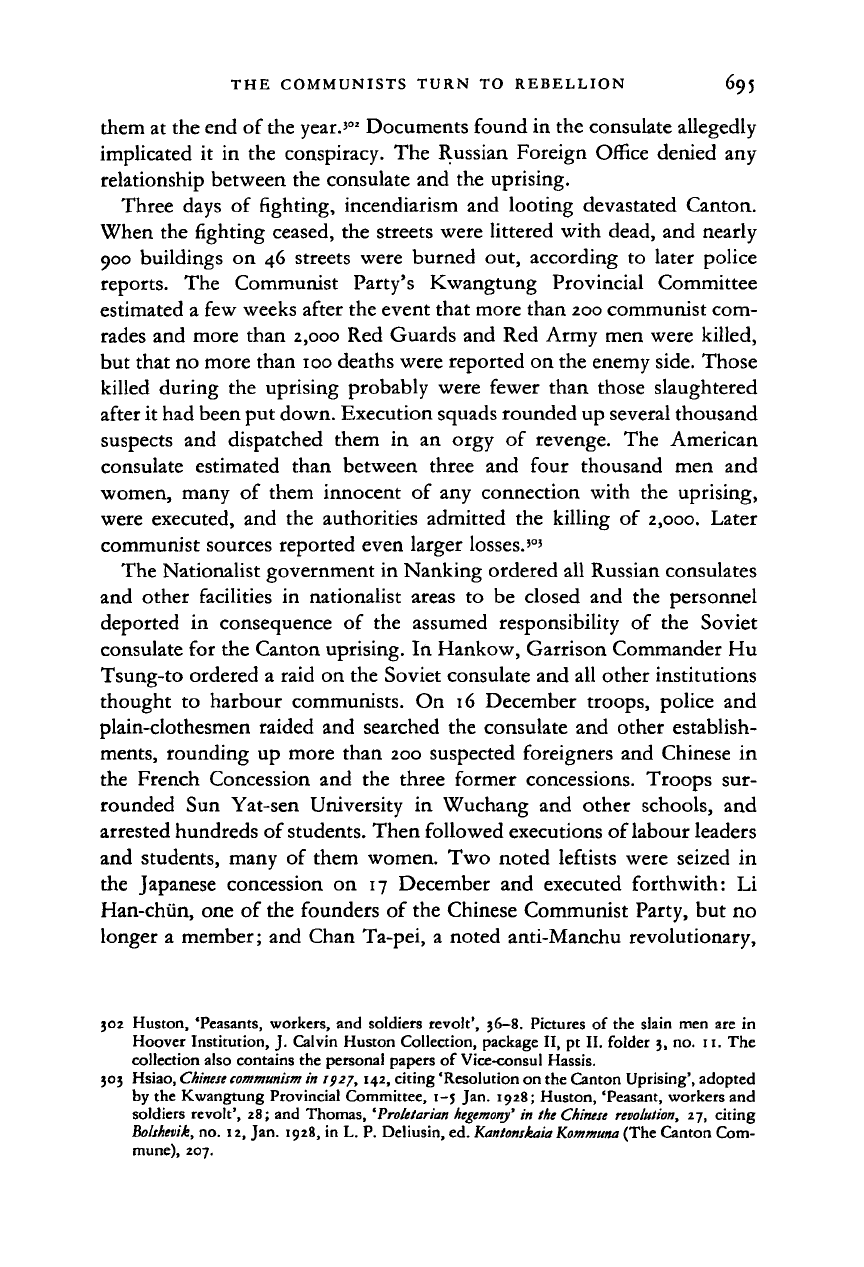
THE COMMUNISTS TURN TO REBELLION 69J
them at the end of the year.'
02
Documents found in the consulate allegedly
implicated it in the conspiracy. The Russian Foreign Office denied any
relationship between the consulate and the uprising.
Three days of fighting, incendiarism and looting devastated Canton.
When the fighting ceased, the streets were littered with dead, and nearly
900 buildings on 46 streets were burned out, according to later police
reports. The Communist Party's Kwangtung Provincial Committee
estimated a few weeks after the event that more than 200 communist com-
rades and more than 2,000 Red Guards and Red Army men were killed,
but that no more than 100 deaths were reported on the enemy side. Those
killed during the uprising probably were fewer than those slaughtered
after it had been put down. Execution squads rounded up several thousand
suspects and dispatched them in an orgy of revenge. The American
consulate estimated than between three and four thousand men and
women, many of them innocent of any connection with the uprising,
were executed, and the authorities admitted the killing of 2,000. Later
communist sources reported even larger losses.'
0
'
The Nationalist government in Nanking ordered all Russian consulates
and other facilities in nationalist areas to be closed and the personnel
deported in consequence of the assumed responsibility of the Soviet
consulate for the Canton uprising. In Hankow, Garrison Commander Hu
Tsung-to ordered a raid on the Soviet consulate and all other institutions
thought to harbour communists. On 16 December troops, police and
plain-clothesmen raided and searched the consulate and other establish-
ments, rounding up more than 200 suspected foreigners and Chinese in
the French Concession and the three former concessions. Troops sur-
rounded Sun Yat-sen University in Wuchang and other schools, and
arrested hundreds of
students.
Then followed executions of labour leaders
and students, many of them women. Two noted leftists were seized in
the Japanese concession on 17 December and executed forthwith: Li
Han-chiin, one of the founders of the Chinese Communist Party, but no
longer a member; and Chan Ta-pei, a noted anti-Manchu revolutionary,
302 Huston, 'Peasants, workers, and soldiers revolt', 36-8. Pictures of the slain men are in
Hoover Institution, J. Calvin Huston Collection, package II, pt II. folder 3, no. 11. The
collection also contains the personal papers of Vice-consul Hassis.
303 Hsiao,
Chinese communism
in 1927, 142, citing 'Resolution on the Canton Uprising', adopted
by the Kwangtung Provincial Committee, 1-5 Jan. 1928; Huston, 'Peasant, workers and
soldiers revolt', 28; and Thomas,
'Proletarian
hegemony'
in the
Chinese
revolution,
27, citing
Bolshevik,
no. 12, Jan. 1928, in L. P. Deliusin, ed.
Kantonskaia Kommuna
(The Canton Com-
mune), 207.
Cambridge Histories Online © Cambridge University Press, 2008
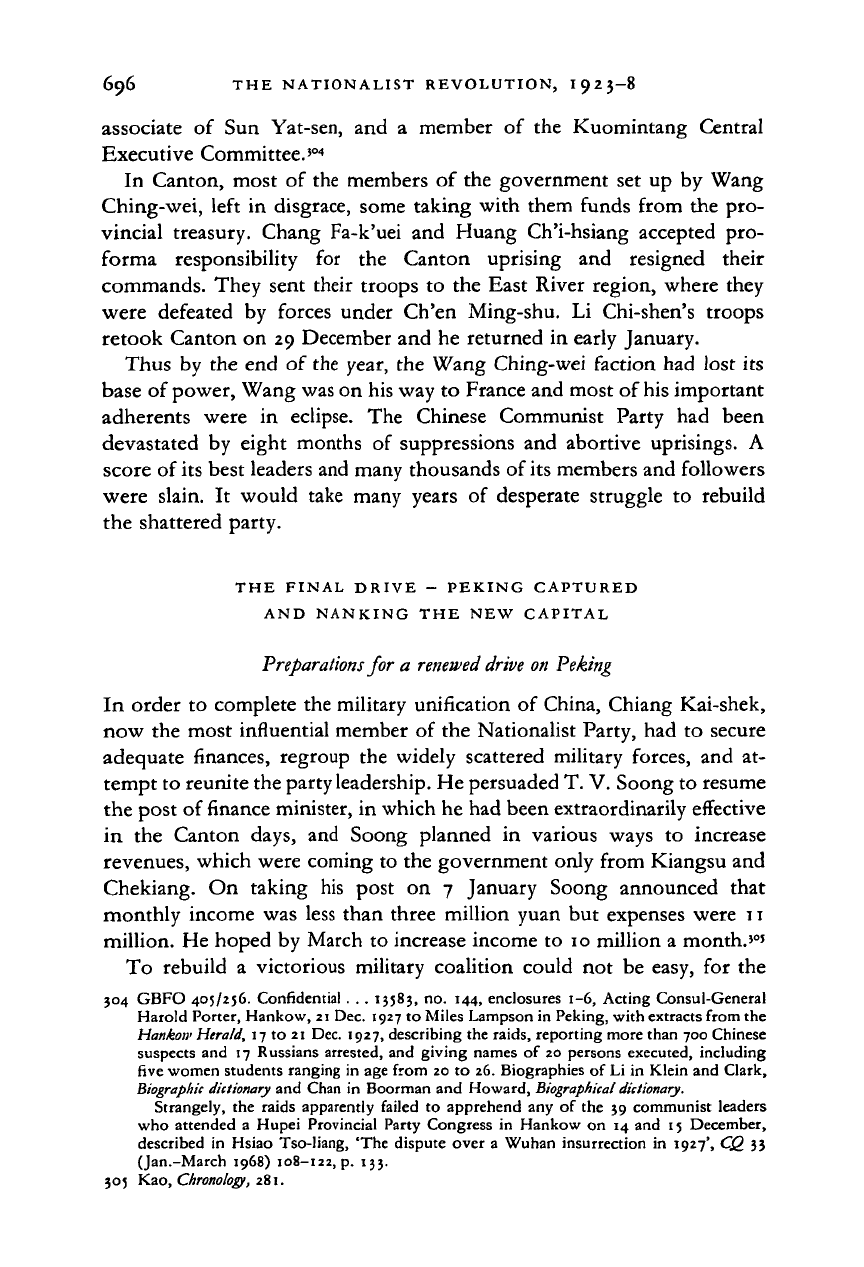
696 THE NATIONALIST REVOLUTION, I 9
2
3-8
associate
of
Sun
Yat-sen,
and
a
member
of
the
Kuomintang Central
Executive Committee.'
04
In Canton, most
of
the
members
of
the
government
set up by
Wang
Ching-wei, left
in
disgrace, some taking with them funds from
the pro-
vincial treasury. Chang Fa-k'uei
and
Huang Ch'i-hsiang accepted
pro-
forma responsibility
for the
Canton uprising
and
resigned their
commands. They sent their troops
to
the
East River region, where they
were defeated
by
forces under Ch'en Ming-shu.
Li
Chi-shen's troops
retook Canton
on 29
December
and he
returned
in
early January.
Thus
by the end
of
the year,
the
Wang Ching-wei faction
had
lost
its
base
of
power, Wang was
on
his way
to
France
and
most
of
his important
adherents were
in
eclipse.
The
Chinese Communist Party
had
been
devastated
by
eight months
of
suppressions
and
abortive uprisings.
A
score
of
its best leaders
and
many thousands
of
its members
and
followers
were slain.
It
would take many years
of
desperate struggle
to
rebuild
the shattered party.
THE FINAL DRIVE - PEKING CAPTURED
AND NANKING THE NEW CAPITAL
Preparations for
a
renewed drive
on Peking
In order
to
complete
the
military unification
of
China, Chiang Kai-shek,
now
the
most influential member
of
the
Nationalist Party,
had
to
secure
adequate finances, regroup
the
widely scattered military forces,
and
at-
tempt
to
reunite the party
leadership.
He persuaded
T.
V. Soong
to
resume
the post
of
finance minister,
in
which
he had
been extraordinarily effective
in
the
Canton days,
and
Soong planned
in
various ways
to
increase
revenues, which were coming
to the
government only from Kiangsu
and
Chekiang.
On
taking
his
post
on 7
January Soong announced that
monthly income
was
less than three million yuan
but
expenses were
11
million.
He
hoped
by
March
to
increase income
to 10
million
a
month.'
0
'
To rebuild
a
victorious military coalition could
not
be
easy,
for
the
304 GBFO 405/256. Confidential
. . .
15583, no. 144, enclosures
1-6,
Acting Consul-General
Harold Porter, Hankow,
21
Dec. 1927
to
Miles Lampson
in
Peking, with extracts from the
Hankow
Herald,
17
to
21 Dec. 1927, describing the raids, reporting more than 700 Chinese
suspects
and 17
Russians arrested,
and
giving names
of
20 persons executed, including
five women students ranging
in
age from 20
to
26. Biographies
of
Li
in
Klein and Clark,
Biographic dictionary
and
Chan
in
Boorman
and
Howard,
Biographical
dictionary.
Strangely,
the
raids apparently failed
to
apprehend
any of
the
39
communist leaders
who attended
a
Hupei Provincial Party Congress
in
Hankow
on
14
and 15
December,
described
in
Hsiao Tso-liang, 'The dispute over
a
Wuhan insurrection
in
1927', CQ
33
(Jan.-March 1968) 108-122, p. 133.
305 Kao,
Chronology,
281.
Cambridge Histories Online © Cambridge University Press, 2008
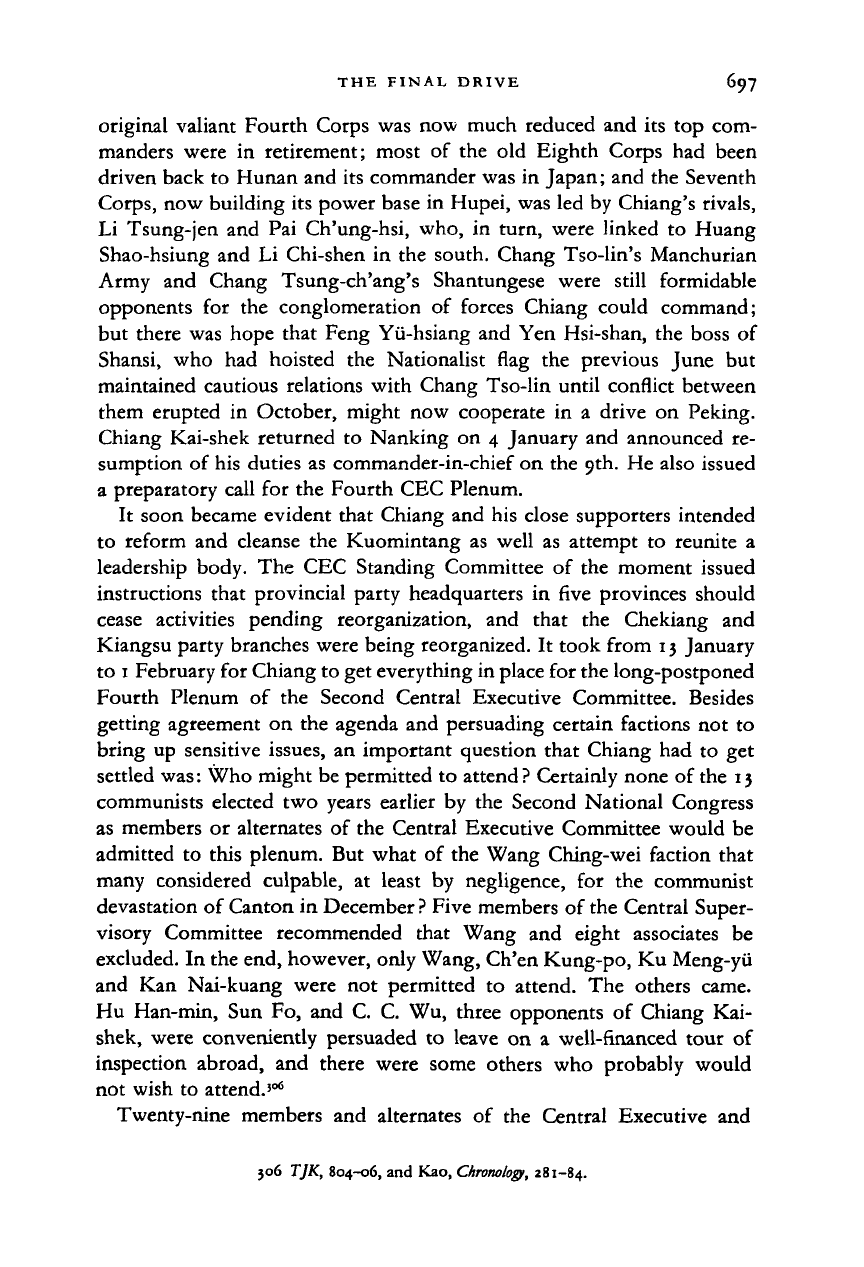
THE FINAL DRIVE 697
original valiant Fourth Corps
was now
much reduced
and its top com-
manders were
in
retirement; most
of the old
Eighth Corps
had
been
driven back
to
Hunan and
its
commander was
in
Japan;
and the
Seventh
Corps, now building
its
power base
in
Hupei, was
led by
Chiang's rivals,
Li Tsung-jen
and Pai
Ch'ung-hsi,
who, in
turn, were linked
to
Huang
Shao-hsiung
and Li
Chi-shen
in the
south. Chang Tso-lin's Manchurian
Army
and
Chang Tsung-ch'ang's Shantungese were still formidable
opponents
for the
conglomeration
of
forces Chiang could command;
but there
was
hope that Feng Yii-hsiang
and Yen
Hsi-shan,
the
boss
of
Shansi,
who had
hoisted
the
Nationalist flag
the
previous June
but
maintained cautious relations with Chang Tso-lin until conflict between
them erupted
in
October, might
now
cooperate
in a
drive
on
Peking.
Chiang Kai-shek returned
to
Nanking
on 4
January
and
announced
re-
sumption
of
his duties
as
commander-in-chief on
the
9th.
He
also issued
a preparatory call
for the
Fourth CEC Plenum.
It soon became evident that Chiang
and his
close supporters intended
to reform
and
cleanse
the
Kuomintang
as
well
as
attempt
to
reunite
a
leadership body.
The CEC
Standing Committee
of the
moment issued
instructions that provincial party headquarters
in
five provinces should
cease activities pending reorganization,
and
that
the
Chekiang
and
Kiangsu party branches were being reorganized.
It
took from 13 January
to
1
February
for
Chiang to get everything in place
for
the long-postponed
Fourth Plenum
of the
Second Central Executive Committee. Besides
getting agreement
on the
agenda
and
persuading certain factions
not to
bring
up
sensitive issues,
an
important question that Chiang
had to get
settled was: Who might
be
permitted
to
attend
?
Certainly none
of
the
13
communists elected
two
years earlier
by the
Second National Congress
as members
or
alternates
of
the Central Executive Committee would
be
admitted
to
this plenum.
But
what
of the
Wang Ching-wei faction that
many considered culpable,
at
least
by
negligence,
for the
communist
devastation
of
Canton
in
December
?
Five members
of
the Central Super-
visory Committee recommended that Wang
and
eight associates
be
excluded.
In
the end, however, only Wang, Ch'en Kung-po,
Ku
Meng-yii
and
Kan
Nai-kuang were
not
permitted
to
attend.
The
others came.
Hu Han-min,
Sun Fo, and C. C. Wu,
three opponents
of
Chiang
Kai-
shek, were conveniently persuaded
to
leave
on a
well-financed tour
of
inspection abroad,
and
there were some others
who
probably would
not wish
to
attend.'
06
Twenty-nine members
and
alternates
of the
Central Executive
and
306 TJK, 804-06, and Kao,
Chronology,
281-84.
Cambridge Histories Online © Cambridge University Press, 2008
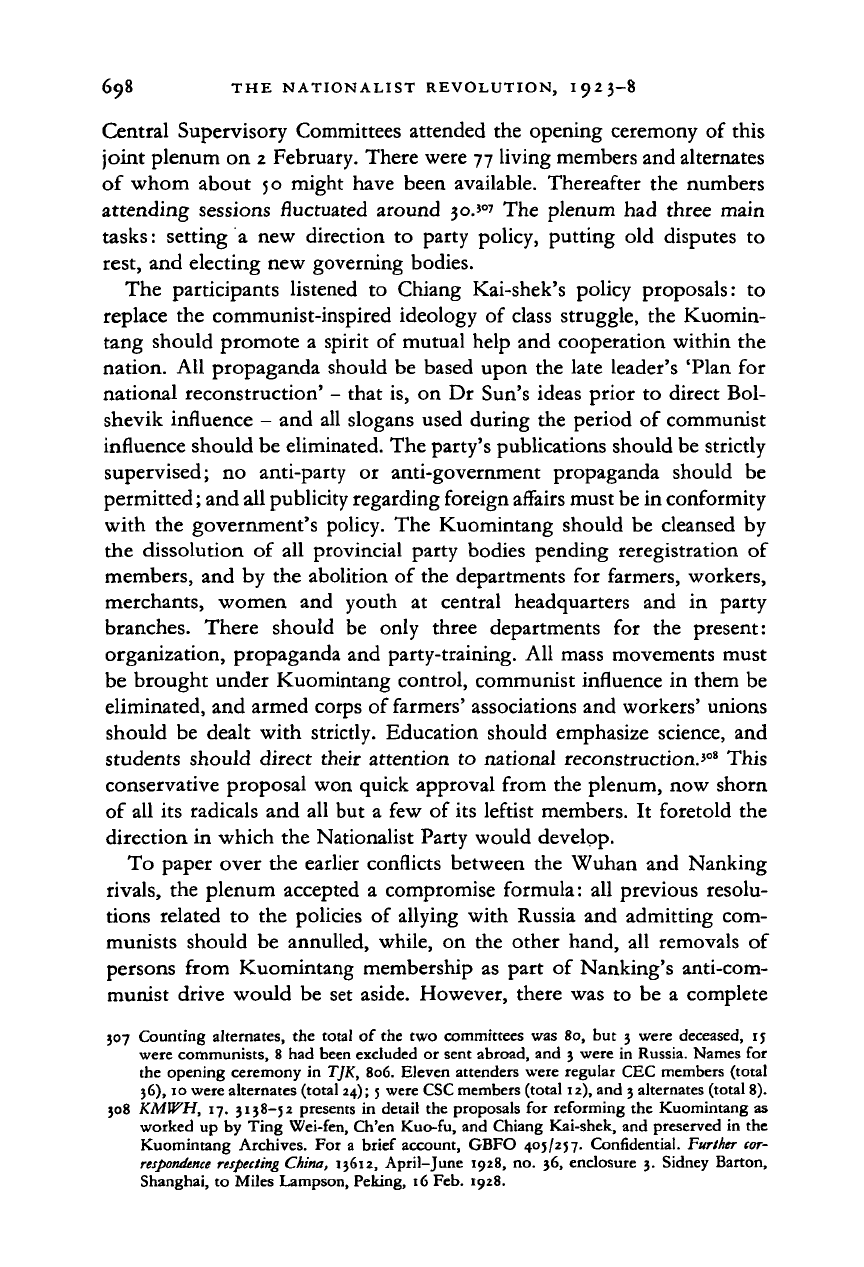
698 THE NATIONALIST REVOLUTION, I923-8
Central Supervisory Committees attended the opening ceremony
of
this
joint plenum on 2 February. There were 77 living members and alternates
of whom about 50 might have been available. Thereafter the numbers
attending sessions fluctuated around 30.'°? The plenum had three main
tasks:
setting
a
new direction
to
party policy, putting
old
disputes
to
rest, and electing new governing bodies.
The participants listened
to
Chiang Kai-shek's policy proposals:
to
replace the communist-inspired ideology
of
class struggle, the Kuomin-
tang should promote
a
spirit
of
mutual help and cooperation within the
nation. All propaganda should be based upon the late leader's 'Plan for
national reconstruction'
-
that is, on
Dr
Sun's ideas prior
to
direct Bol-
shevik influence
-
and all slogans used during the period
of
communist
influence should be eliminated. The party's publications should be strictly
supervised;
no
anti-party
or
anti-government propaganda should
be
permitted; and all publicity regarding foreign affairs must be in conformity
with the government's policy. The Kuomintang should
be
cleansed
by
the dissolution
of
all provincial party bodies pending reregistration
of
members, and
by
the abolition
of
the departments
for
farmers, workers,
merchants, women
and
youth
at
central headquarters
and in
party
branches. There should
be
only three departments
for the
present:
organization, propaganda and party-training. All mass movements must
be brought under Kuomintang control, communist influence in them be
eliminated, and armed corps of farmers' associations and workers' unions
should
be
dealt with strictly. Education should emphasize science, and
students should direct their attention
to
national reconstruction.
5
°
8
This
conservative proposal won quick approval from the plenum, now shorn
of all its radicals and all but
a
few
of
its leftist members.
It
foretold the
direction in which the Nationalist Party would develop.
To paper over the earlier conflicts between the Wuhan and Nanking
rivals,
the plenum accepted
a
compromise formula: all previous resolu-
tions related
to
the policies
of
allying with Russia and admitting com-
munists should
be
annulled, while,
on
the other hand,
all
removals
of
persons from Kuomintang membership
as
part
of
Nanking's anti-com-
munist drive would
be
set aside. However, there was
to be a
complete
307 Counting alternates, the total
of
the two committees was 80,
but 3
were deceased,
15
were communists,
8
had been excluded or sent abroad, and
3
were in Russia. Names for
the opening ceremony
in
TJK, 806. Eleven attenders were regular CEC members (total
36),
10 were alternates (total 24); 5 were CSC members (total 12), and 3 alternates (total 8).
308
KMWH,
17.
3138-52 presents
in
detail the proposals for reforming the Kuomintang
as
worked up by Ting Wei-fen, Ch'en Kuo-fu, and Chiang Kai-shek, and preserved
in
the
Kuomintang Archives. For
a
brief account, GBFO 405/257. Confidential. Further cor-
respondence respecting
China, 13612, April-June 1928, no. 36, enclosure
3.
Sidney Barton,
Shanghai,
to
Miles Lampson, Peking, 16 Feb. 1928.
Cambridge Histories Online © Cambridge University Press, 2008
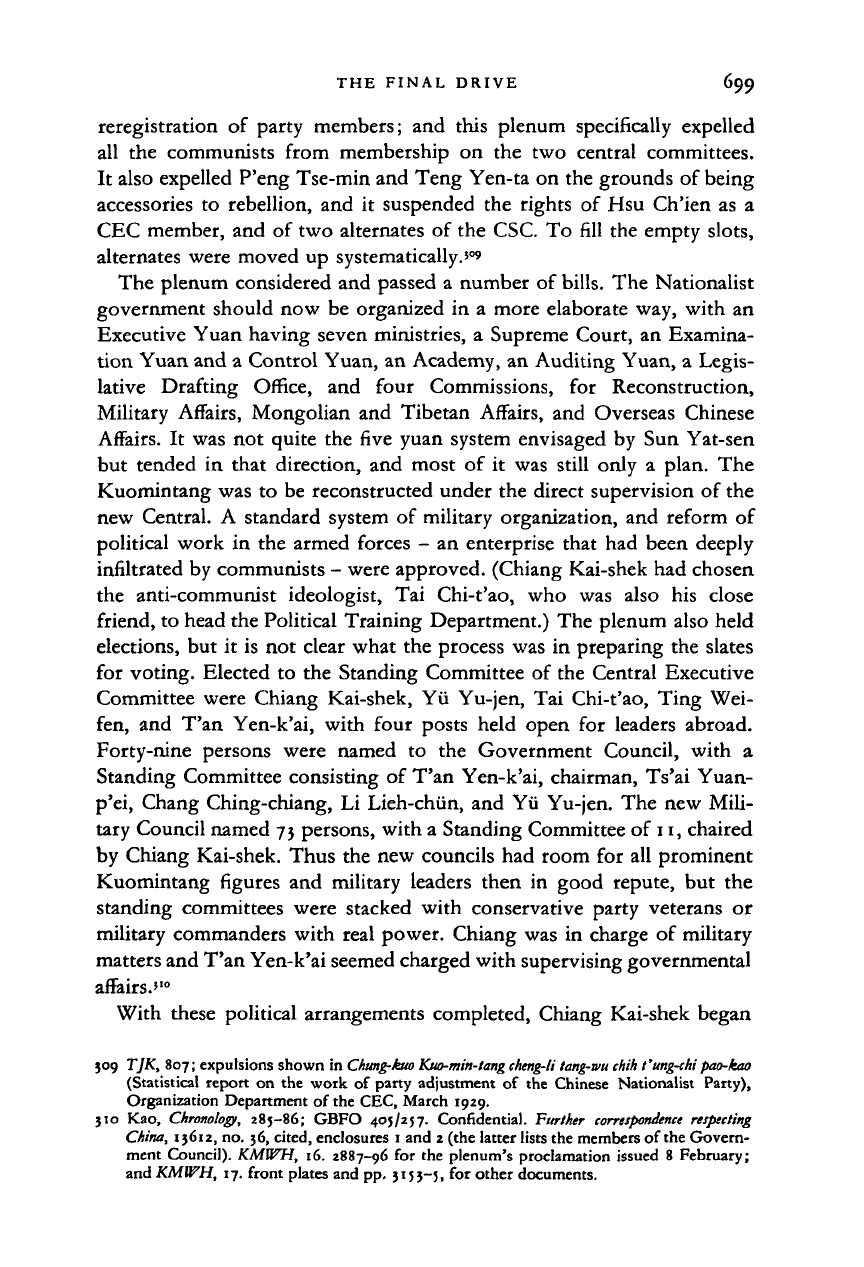
THE FINAL DRIVE 699
reregistration of party members; and this plenum specifically expelled
all the communists from membership on the two central committees.
It also expelled P'eng Tse-min and Teng Yen-ta on the grounds of being
accessories to rebellion, and it suspended the rights of Hsu Ch'ien as a
CEC member, and of two alternates of the CSC. To fill the empty slots,
alternates were moved up systematically.'
09
The plenum considered and passed a number of bills. The Nationalist
government should now be organized in a more elaborate way, with an
Executive Yuan having seven ministries, a Supreme Court, an Examina-
tion Yuan and a Control Yuan, an Academy, an Auditing Yuan, a Legis-
lative Drafting Office, and four Commissions, for Reconstruction,
Military Affairs, Mongolian and Tibetan Affairs, and Overseas Chinese
Affairs. It was not quite the five yuan system envisaged by Sun Yat-sen
but tended in that direction, and most of it was still only a plan. The
Kuomintang was to be reconstructed under the direct supervision of the
new Central. A standard system of military organization, and reform of
political work in the armed forces - an enterprise that had been deeply
infiltrated by communists - were approved. (Chiang Kai-shek had chosen
the anti-communist ideologist, Tai Chi-t'ao, who was also his close
friend, to head the Political Training Department.) The plenum also held
elections, but it is not clear what the process was in preparing the slates
for voting. Elected to the Standing Committee of the Central Executive
Committee were Chiang Kai-shek, Yii Yu-jen, Tai Chi-t'ao, Ting Wei-
fen, and T'an Yen-k'ai, with four posts held open for leaders abroad.
Forty-nine persons were named to the Government Council, with a
Standing Committee consisting of T'an Yen-k'ai, chairman, Ts'ai Yuan-
p'ei,
Chang Ching-chiang, Li Lieh-chun, and Yii Yu-jen. The new Mili-
tary Council named 73 persons, with a Standing Committee of
11,
chaired
by Chiang Kai-shek. Thus the new councils had room for all prominent
Kuomintang figures and military leaders then in good repute, but the
standing committees were stacked with conservative party veterans or
military commanders with real power. Chiang was in charge of military
matters and T'an Yen-k'ai seemed charged with supervising governmental
affairs.'
10
With these political arrangements completed, Chiang Kai-shek began
509 TJK, 807; expulsions shown in
Chtmg-kuo Kuo-min-tang cheng-li tang-wu chih
t'ung-chipao-kao
(Statistical report on the work of party adjustment of the Chinese Nationalist Party),
Organization Department of the CEC, March 1929.
310 Kao,
Chronology,
285-86; GBFO 405/257. Confidential, further
correspondence respecting
China, 13612, no. 36, cited, enclosures 1 and 2 (the latter lists the members of the Govern-
ment Council).
KMWH,
16. 2887-96 for the plenum's proclamation issued 8 February;
and
KMWH,
17. front plates and pp. 3155-5, for other documents.
Cambridge Histories Online © Cambridge University Press, 2008
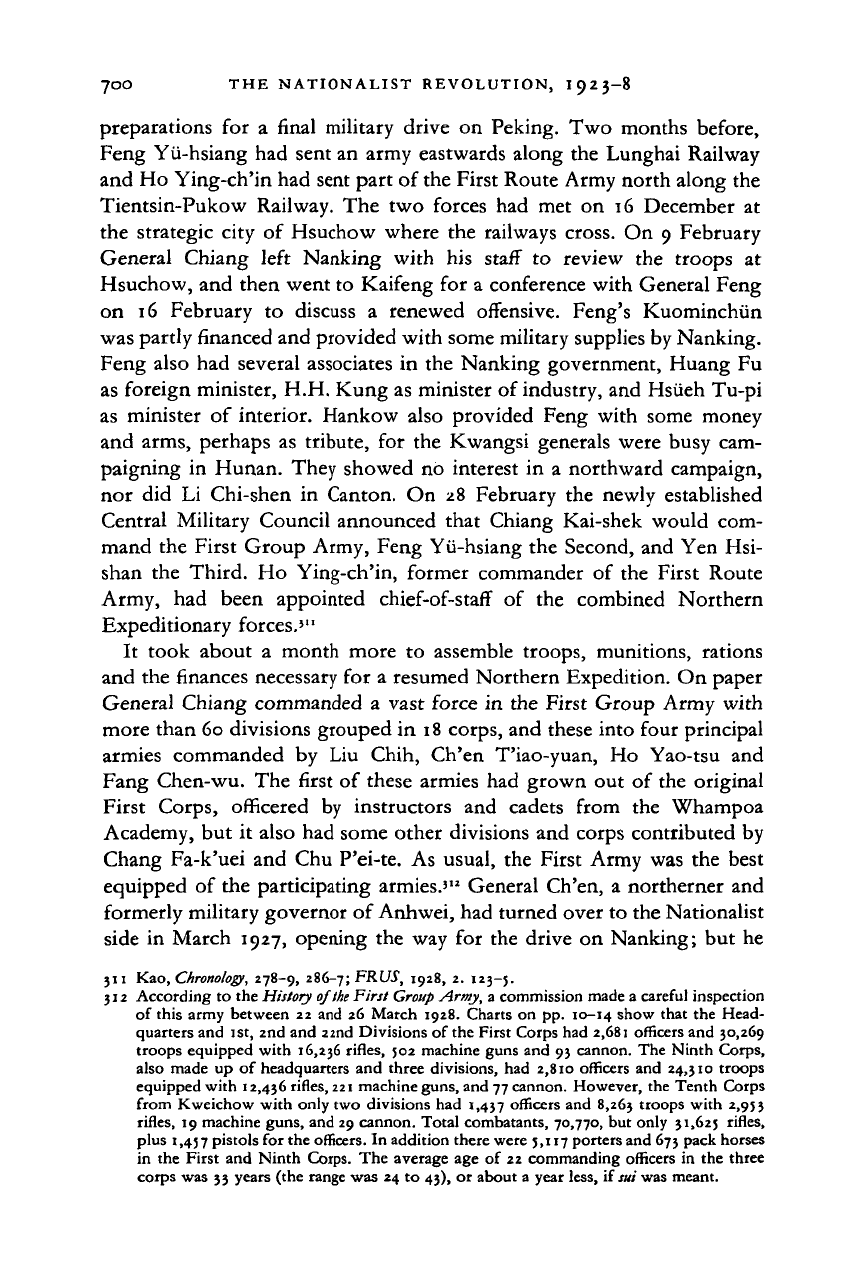
700 THE NATIONALIST REVOLUTION, I 9
2
3-8
preparations
for a
final military drive
on
Peking.
Two
months before,
Feng Yii-hsiang
had
sent
an
army eastwards along
the
Lunghai Railway
and
Ho
Ying-ch'in
had
sent part
of
the First Route Army north along
the
Tientsin-Pukow Railway.
The two
forces
had met
on
16
December
at
the strategic city
of
Hsuchow where
the
railways cross.
On
9
February
General Chiang left Nanking with
his
staff
to
review
the
troops
at
Hsuchow,
and
then went
to
Kaifeng
for
a
conference with General Feng
on
16
February
to
discuss
a
renewed offensive. Feng's Kuominchiin
was partly financed
and
provided with some military supplies by Nanking.
Feng also
had
several associates
in
the
Nanking government, Huang
Fu
as foreign minister, H.H. Kung
as
minister
of
industry,
and
Hsiieh Tu-pi
as minister
of
interior. Hankow also provided Feng with some money
and arms, perhaps
as
tribute,
for
the
Kwangsi generals were busy
cam-
paigning
in
Hunan. They showed
no
interest
in a
northward campaign,
nor
did
Li
Chi-shen
in
Canton.
On 28
February
the
newly established
Central Military Council announced that Chiang Kai-shek would
com-
mand
the
First Group Army, Feng Yii-hsiang
the
Second,
and Yen Hsi-
shan
the
Third.
Ho
Ying-ch'in, former commander
of
the
First Route
Army,
had
been appointed chief-of-staff
of the
combined Northern
Expeditionary forces.
5
"
It took about
a
month more
to
assemble troops, munitions, rations
and
the
finances necessary
for
a
resumed Northern Expedition.
On
paper
General Chiang commanded
a
vast force
in
the
First Group Army with
more than
60
divisions grouped
in
18 corps,
and
these into four principal
armies commanded
by Liu
Chih, Ch'en T'iao-yuan,
Ho
Yao-tsu
and
Fang Chen-wu.
The
first
of
these armies
had
grown
out
of
the
original
First Corps, officered
by
instructors
and
cadets from
the
Whampoa
Academy,
but
it
also
had
some other divisions
and
corps contributed
by
Chang Fa-k'uei
and Chu
P'ei-te.
As
usual,
the
First Army
was the
best
equipped
of
the
participating armies.'
12
General Ch'en,
a
northerner
and
formerly military governor
of
Anhwei,
had
turned over
to the
Nationalist
side
in
March
1927,
opening
the way
for
the
drive
on
Nanking;
but
he
311 Kao,
Chronology,
278-9, 286-7; FRUS, 1928,
2.
123-5.
312 According
to
the History of
the
First
Group
Army,
a
commission made
a
careful inspection
of this army between
22 and 26
March 1928. Charts
on
pp. 10-14 show that
the
Head-
quarters and 1st, 2nd and 22nd Divisions
of
the First Corps had 2,681 officers and 30,269
troops equipped with 16,236 rifles, 502 machine guns
and
93 cannon. The Ninth Corps,
also made
up of
headquarters
and
three divisions,
had
2,810 officers
and
24,310 troops
equipped with 12,436 rifles,
221
machine guns, and 77 cannon. However,
the
Tenth Corps
from Kweichow with only two divisions
had
1,437 officers and
8,263
troops with 2,953
rifles,
19 machine guns, and 29 cannon. Total combatants, 70,770, but only $1,625 rifles,
plus 1,457 pistols for the officers.
In
addition there were 5,117 porters and 673 pack horses
in
the
First
and
Ninth Corps.
The
average
age of
22 commanding officers
in the
three
corps was 33 years (the range was 24
to
43),
or
about
a
year less,
if
sui
was meant.
Cambridge Histories Online © Cambridge University Press, 2008
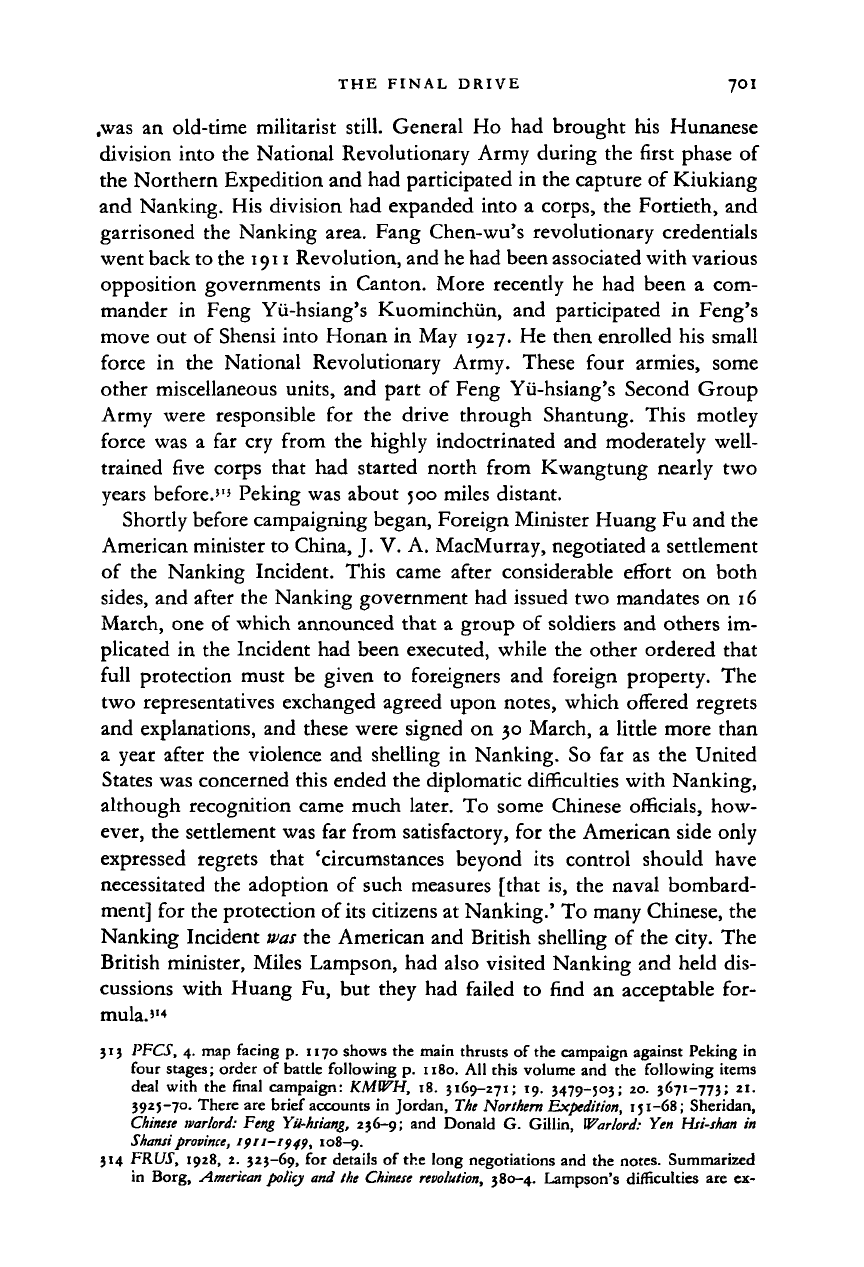
THE FINAL DRIVE 7OI
.was an old-time militarist still. General Ho had brought his Hunanese
division into the National Revolutionary Army during the first phase of
the Northern Expedition and had participated in the capture of Kiukiang
and Nanking. His division had expanded into a corps, the Fortieth, and
garrisoned the Nanking area. Fang Chen-wu's revolutionary credentials
went back to the 1911 Revolution, and he had been associated with various
opposition governments in Canton. More recently he had been a com-
mander in Feng Yii-hsiang's Kuominchiin, and participated in Feng's
move out of Shensi into Honan in May 1927. He then enrolled his small
force in the National Revolutionary Army. These four armies, some
other miscellaneous units, and part of Feng Yii-hsiang's Second Group
Army were responsible for the drive through Shantung. This motley
force was a far cry from the highly indoctrinated and moderately well-
trained five corps that had started north from Kwangtung nearly two
years before.'
1
' Peking was about 500 miles distant.
Shortly before campaigning began, Foreign Minister Huang Fu and the
American minister to China, J. V. A. MacMurray, negotiated a settlement
of the Nanking Incident. This came after considerable effort on both
sides,
and after the Nanking government had issued two mandates on 16
March, one of which announced that a group of soldiers and others im-
plicated in the Incident had been executed, while the other ordered that
full protection must be given to foreigners and foreign property. The
two representatives exchanged agreed upon notes, which offered regrets
and explanations, and these were signed on 30 March, a little more than
a year after the violence and shelling in Nanking. So far as the United
States was concerned this ended the diplomatic difficulties with Nanking,
although recognition came much later. To some Chinese officials, how-
ever, the settlement was far from satisfactory, for the American side only
expressed regrets that 'circumstances beyond its control should have
necessitated the adoption of such measures [that is, the naval bombard-
ment] for the protection of
its
citizens at Nanking.' To many Chinese, the
Nanking Incident
was
the American and British shelling of the city. The
British minister, Miles Lampson, had also visited Nanking and held dis-
cussions with Huang Fu, but they had failed to find an acceptable for-
mula.'
14
313 PFCS, 4. map facing p. 1170 shows the main thrusts of the campaign against Peking in
four stages; order of battle following p. 1180. All this volume and the following items
deal with the final campaign: KM1VH, 18. 5169-271; 19. 3479-503; 20. 3671-773; 21.
3925-70. There are brief accounts in Jordan, The Northern Expedition, 151-68; Sheridan,
Chinese
warlord: Feng
Yii-hsiang,
236-9; and Donald G. Gillin, Warlord: Yen Hsi-shan in
Shansiprovince,
ipn-ifjf,
108-9.
314 FRUS, 1928, 1. 323-69, for details of the long negotiations and the notes. Summarized
in Borg, American policy and the
Chinese
revolution,
380-4. Lampson's difficulties are ex-
Cambridge Histories Online © Cambridge University Press, 2008
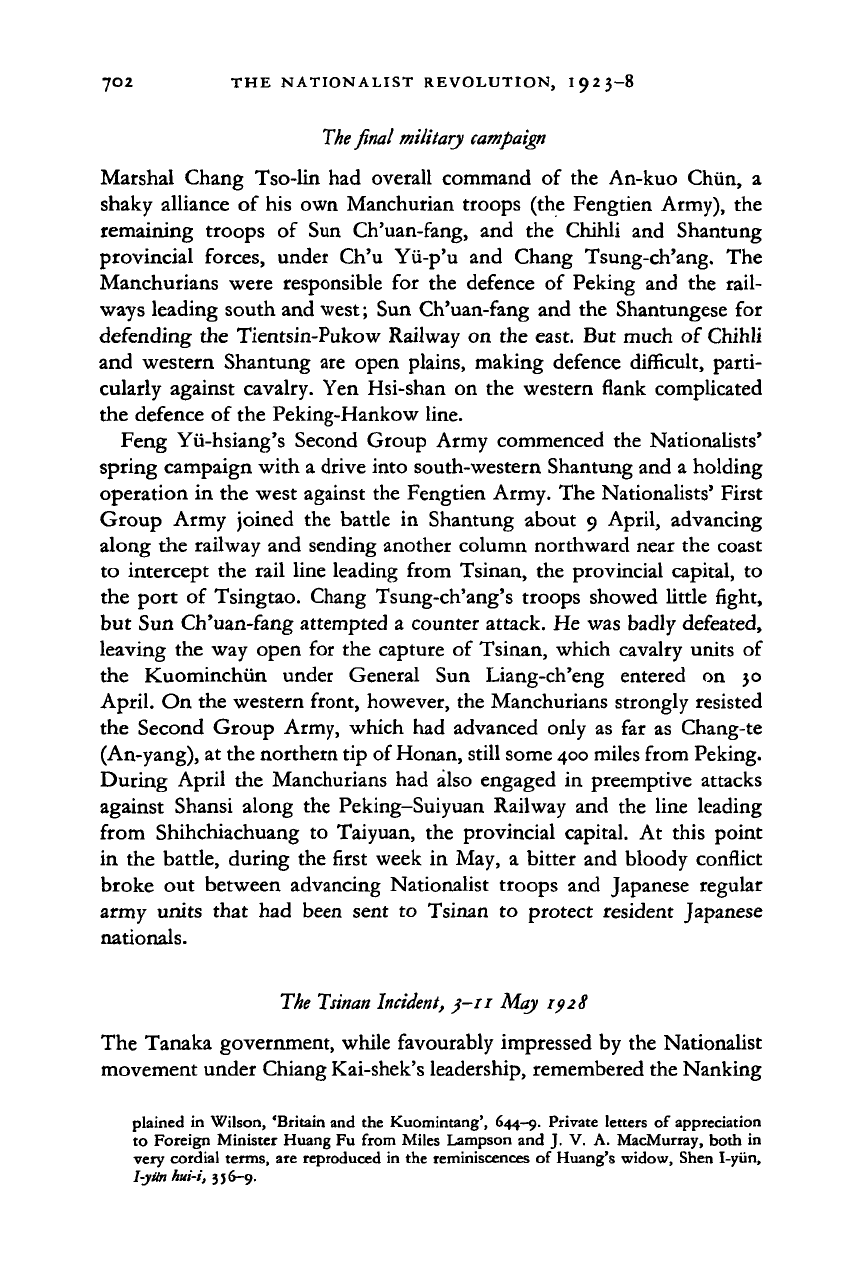
•JOZ
THE NATIONALIST REVOLUTION, I 9
2
3-8
The final military campaign
Marshal Chang Tso-lin
had
overall command
of the
An-kuo Chiin,
a
shaky alliance
of
his own Manchurian troops (the Fengtien Army),
the
remaining troops
of Sun
Ch'uan-fang,
and the
Chihli
and
Shantung
provincial forces, under
Ch'u
Yii-p'u
and
Chang Tsung-ch'ang.
The
Manchurians were responsible
for the
defence
of
Peking
and the
rail-
ways leading south and west; Sun Ch'uan-fang and
the
Shantungese
for
defending the Tientsin-Pukow Railway
on
the east. But much
of
Chihli
and western Shantung
are
open plains, making defence difficult, parti-
cularly against cavalry. Yen Hsi-shan
on the
western flank complicated
the defence
of
the Peking-Hankow line.
Feng Yii-hsiang's Second Group Army commenced
the
Nationalists'
spring campaign with
a
drive into south-western Shantung and a holding
operation
in
the west against the Fengtien Army. The Nationalists' First
Group Army joined
the
battle
in
Shantung about
9
April, advancing
along the railway and sending another column northward near the coast
to intercept
the
rail line leading from Tsinan,
the
provincial capital,
to
the port
of
Tsingtao. Chang Tsung-ch'ang's troops showed little fight,
but Sun Ch'uan-fang attempted
a
counter attack. He was badly defeated,
leaving
the
way open
for the
capture
of
Tsinan, which cavalry units
of
the Kuominchun under General
Sun
Liang-ch'eng entered
on 30
April.
On
the western front, however, the Manchurians strongly resisted
the Second Group Army, which
had
advanced only
as far as
Chang-te
(An-yang), at the northern tip of Honan, still some 400 miles from Peking.
During April
the
Manchurians
had
also engaged
in
preemptive attacks
against Shansi along
the
Peking-Suiyuan Railway
and the
line leading
from Shihchiachuang
to
Taiyuan,
the
provincial capital.
At
this point
in
the
battle, during
the
first week
in
May,
a
bitter and bloody conflict
broke
out
between advancing Nationalist troops
and
Japanese regular
army units that
had
been sent
to
Tsinan
to
protect resident Japanese
nationals.
The
Tsinan
Incident,
)-n
May 1928
The Tanaka government, while favourably impressed
by
the Nationalist
movement under Chiang Kai-shek's leadership, remembered the Nanking
plained
in
Wilson, 'Britain and
the
Kuomintang', 644-9. Private letters
of
appreciation
to Foreign Minister Huang Fu from Miles Lampson and
J. V. A.
MacMurray, both
in
very cordial terms, are reproduced
in
the reminiscences
of
Huang's widow, Shen I-yiin,
I-ji/n
hui-i, $56-9.
Cambridge Histories Online © Cambridge University Press, 2008
